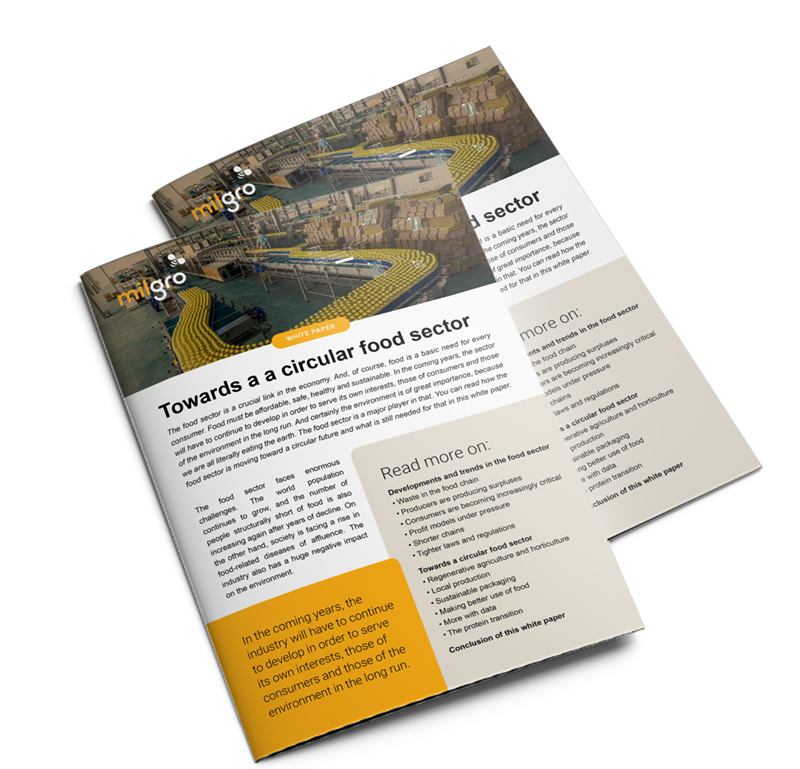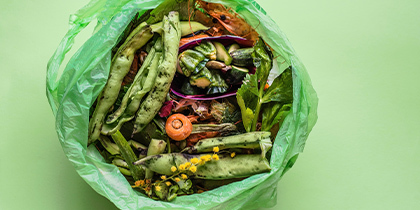This week (September 8 to 14) is Waste-Free Week. In this way, the Foundation Together Against Food Waste makes people aware of how much food is thrown away unnecessarily.
At Milgro, we work daily to prevent (food) waste - both at our partners and at our own office. The Waste Free Week is a great opportunity for us to reflect on the bigger goal: a world without food waste. What does that actually look like?
A world without hunger
In our podcast Resource for Thought, a statement came up that stuck: "If we solve the problem of food waste, no one will have to go hungry anymore." In theory, that's true: worldwide, one-third of all food is lost. That's 1.05 billion tons of food a year, accounting for over a billion meals a day. A shame, considering that in the world 800 million people suffer from hunger. So the food that is being lost now would be more than enough to feed everyone in the world.
Waste occurs throughout the food chain, from the land to the plate. About 11% of waste is caused by the consumer. These are the leftovers that remain on the plate, in the refrigerator, or during preparation.
The battle with the bell pepper .jpg?width=161&height=161&name=LinkedIn%20(78).jpg)
You've probably made a dish with peppers before. The knife goes in, trying to cut out the seeds with an incompatible combination of precision and haste, and the stem off. How much bell pepper do you keep and how much goes into the trash? Quite a bit. Not to mention that green bell pepper, which, of the set of three colored ones, remains in the vegetable bin most often anyway.
Food is wasted throughout the chain
The hospitality sector accounts for 5% of the waste, retail 2.5%. That's the day-fresh pastry from the coffee shop that's left at the end of the day. Or the produce from the supermarket that has passed its expiration date. During the production phase, 13% of all food is lost. All this food waste is not only a waste, and a real shame given the level of hunger in certain parts of the world, but it also has a significant environmental impact, it has been calculated. Food loss and waste accounts for 8 to 10% of global CO2 emmisions, far more than aviation, for example. This, by the way, does not lead to the conclusion: I have emptied my plate, so we can go on a plane vacation....
From the problems to the solution
Enough about the causes surrounding food waste. Let's look at the solution: the waste-free world. In the waste-free world, food waste is solved in all links of the food chain.
From the farmer...
At the production stage, for example, all harvesting methods are completely optimized. Farmland is used diversely, with a different crop each year. Diverse use of farmland improves soil health, reducing the risk of lost harvests. And with the help of robots and AI, farmers can harvest their produce just in time. No more overripe pears fall off the tree.
Through the store and restaurant...
Stricter European regulations have been implemented in supermarkets, which include clarifying date labels. Unclear labels are one of the bigger causes of food waste. Europe's goal is a 10% reduction in food waste by 2030.
Supermarkets are also buying more competitively and smart technologies are being used to extend the shelf life of products. An innovative fog curtain keeps produce on the vegetable shelf fresh for up to twice as long. And there are many more measures to be taken in the retail sector.
Zero Waste cooks and more
In restaurants, overstuffed plates larger than the stomach are a thing of the past. Portioning is geared to the stomach, not the eyes. All you can eat restaurants have disappeared from the scene, as have hotels with breakfast buffets displayed on meter-long sideboards. Chefs in restaurants, as well as in nursing homes and hospitals, have all trained as Zero Waste Chefs; from truly all products, pretty or otherwise, they make the most appetizing dishes. The waste bins in every restaurant and hospital are equipped with monitoring tools that quickly scan what waste is being thrown away in order to take measures towards zero waste.
A more complex story
Of course, these are all solutions that can significantly reduce food waste. But the complexity surrounding combating food waste is more than the sum of these individual measures. There is a complex logistics and storage issue surrounding food waste and thus food availability. In theory, the statement from the beginning of this article is correct; the challenge is to balance the world's food surplus and shortage. Once that balance is found, we can truly speak of a waste-free world.
That means greatly improving food storage facilities, as well as transportation facilities. The lack of cold stores in India leads to major crop losses. Less developed infrastructure in West Africa causes nearly 40% loss of fruit crops. Once at the border, customs regulations can also delay fresh produce from being spoiled.
Transportation and storage
There are hopeful developments addressing this storage and transportation issue, such as in Kenya the company Twiga, which uses smart software to connect farmers to retailers. Farmlink project in America helps farmers with excess production transport their produce to areas with shortages. And Hello Tractor in Nigeria makes it easy to rent a tractor nearby for a good harvest. Closer to home is Local2Local, which promotes local production and shorter chains. These solutions for better storage and logistics, plus the measures in the chain bring a waste-free world closer.
About the bell pepper
Finally, about that bell pepper. Those seeds and the stem are perhaps less tasty, but they are also edible. The seeds can be put in the ground for your own vegetable garden. And the stalk and the seeds, if cooked through, can be used in a vegetable broth. Just like that forgotten green bell pepper from the vegetable garden.

Whitepaper: towards a circular food sector
The food sector is under pressure: food must be safe, affordable, and sustainable. At the same time, legislation, supply chain partners, and consumers are demanding greater transparency and less waste. Our white paper explains how the sector is moving toward a circular approach — and what's still needed.
Stay informed
Want to stay up to date with the latest developments? Follow us on LinkedIn and Instagram or subscribe to our newsletter. Curious about what Milgro can do for your operations and waste process? Feel free to get in touch .












